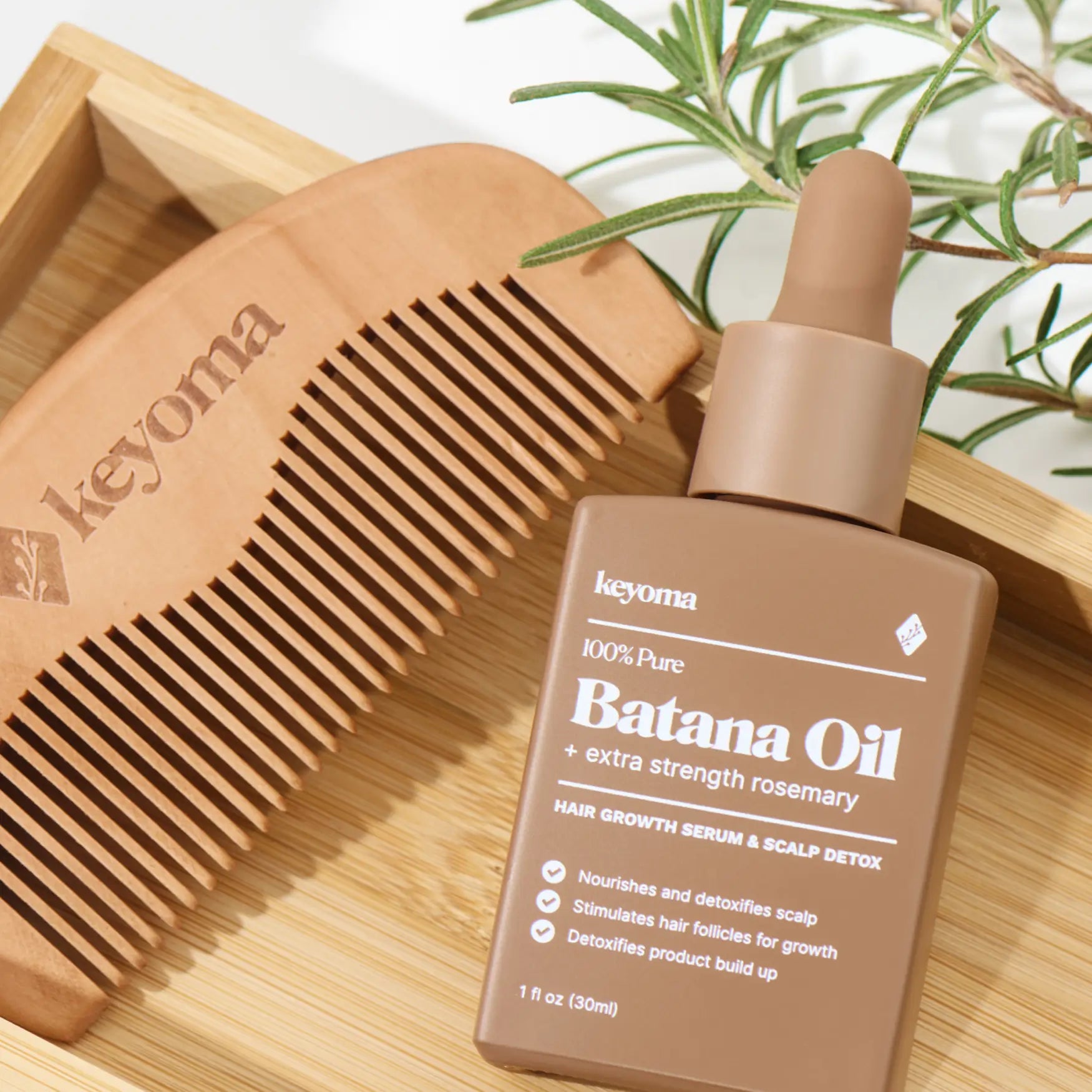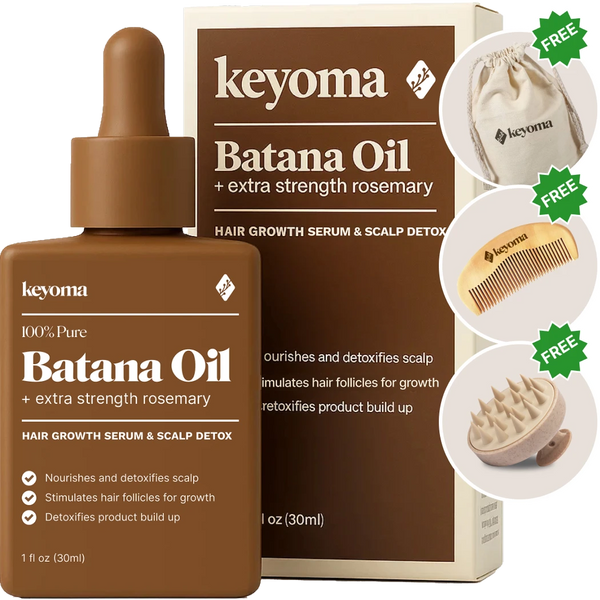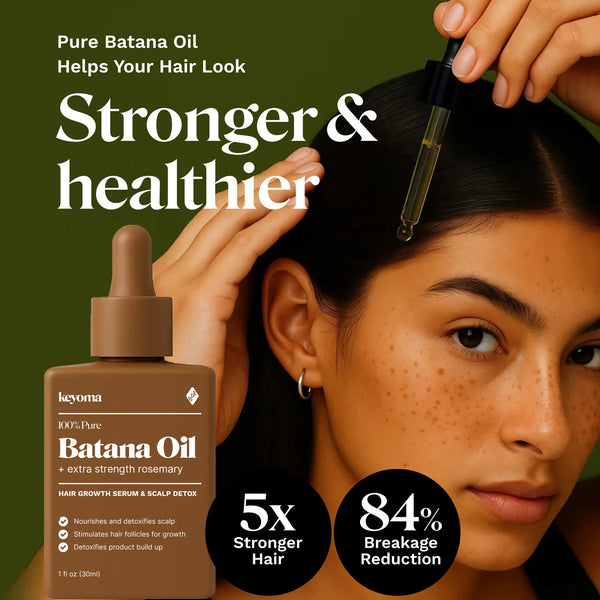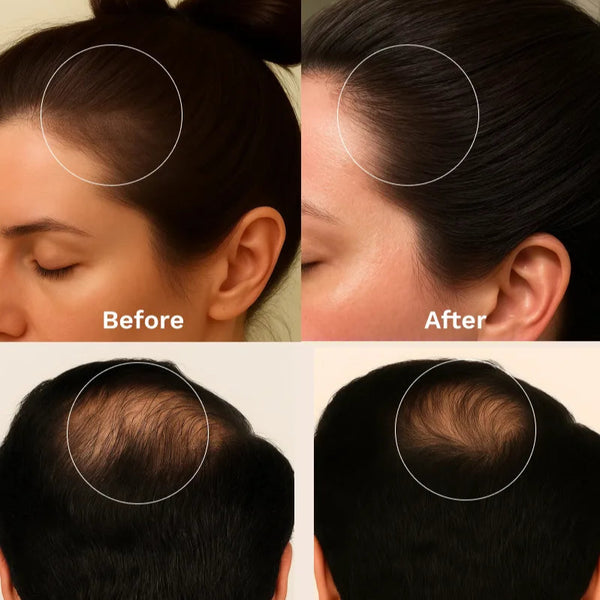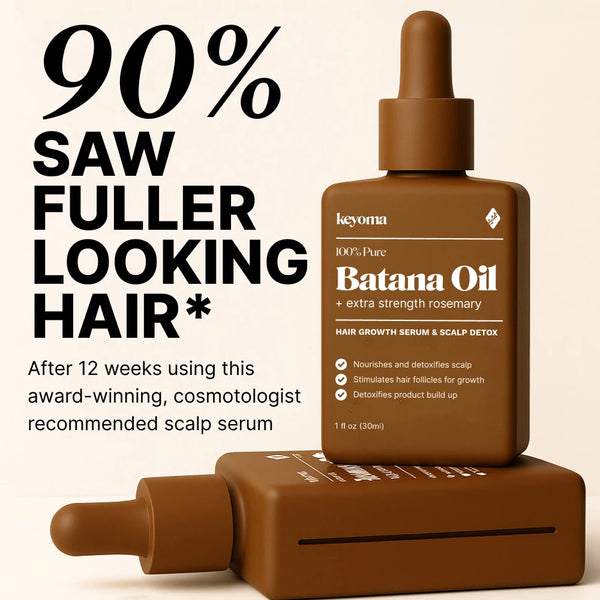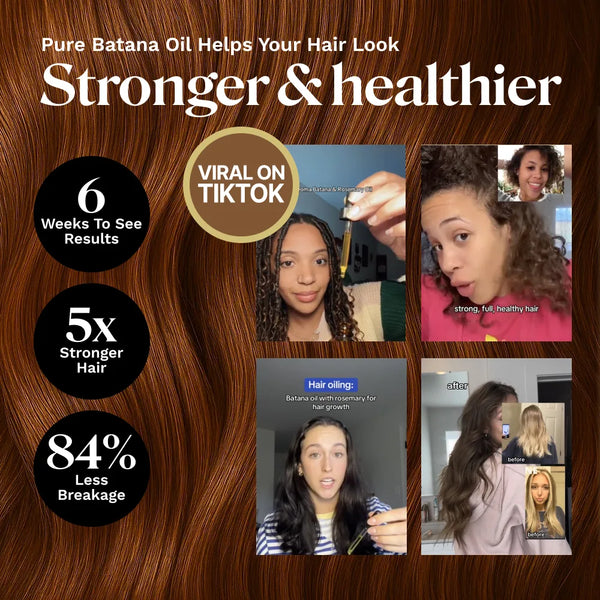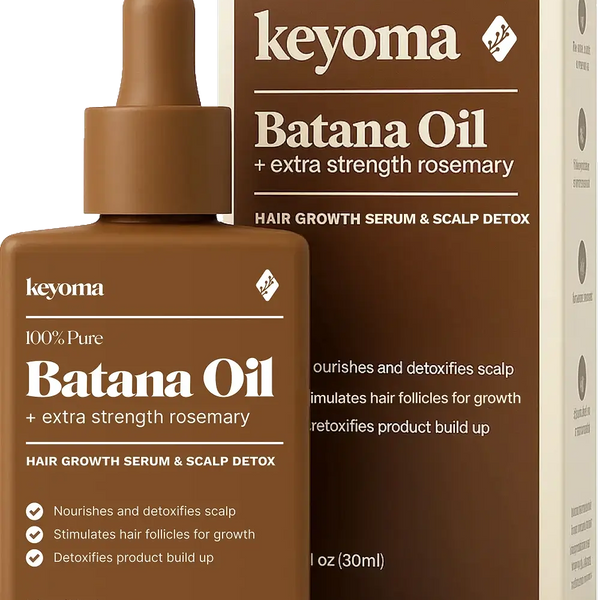In this article
Too little iron in your blood, known as iron deficiency, reduces your body’s ability to make red blood cells, which can leave you feeling exhausted and weak. Research also suggests a possible link between low iron and hair loss. In this article, we will explore how iron deficiency may cause hair loss and the steps you can take to address it.
Key Takeaways
-
Iron deficiency limits red blood cell and haemoglobin production, often from blood loss, poor diet, or pregnancy.
-
Low iron reduces oxygen delivery to hair follicles, slowing repair and growth.
-
Ferritin stores iron, and low levels can trigger hair loss before visible shedding.
-
Signs include fatigue, pale skin, brittle hair, headaches, shortness of breath, heart palpitations, restless legs, and spoon-shaped nails.
-
Excess iron from genetics or high supplement use can also cause hair loss.
-
Maintain an iron-rich diet, boost absorption with vitamin C, avoid harsh treatments, and use nourishing oils like Batana and rosemary.
-
Keyoma Batana Oil offers a natural, plant-based option to support scalp health and hair growth.
What is Iron Deficiency and Anemia?
Iron deficiency occurs when your blood contains too little iron. This essential trace element comes from the foods you eat or from supplements like iron tablets.
While a poor diet can cause iron deficiency, it is more often linked to internal bleeding or, in women, heavy menstrual bleeding and pregnancy. Experts estimate that over 500 million people worldwide are affected.
When iron levels drop too low, you may develop anaemia, a condition in which your body cannot produce enough red blood cells or haemoglobin to carry oxygen to your tissues. This can leave you feeling weak and fatigued.
Iron deficiency anaemia is most common in women of childbearing age because of blood loss during periods and increased demands during pregnancy. According to WHO about 23% of pregnant women and 14% of non-pregnant women are believed to experience this condition.
Why Iron Deficiency Leads to Hair Thinning
Hair loss can have many causes and can affect children and adults of all genders. One common reason for excessive hair shedding is iron deficiency. Without adequate iron, your body cannot produce enough haemoglobin, the protein in blood that carries oxygen. Oxygen is essential for repairing damaged cells, including those that support hair growth.
Iron deficiency–related hair loss often resembles typical hair loss in both men and women. You may notice more strands coming out than usual when brushing or washing your hair, and in severe cases, bald patches may appear on the scalp.
How Low Ferritin Levels Affect Hair Growth
The term “ferritin” may be unfamiliar to many people. Ferritin is a blood protein that stores iron for your body’s use. Low ferritin levels indicate iron deficiency, which can increase the risk of hair loss.
Some ferritin is stored in hair follicles. Many assume that significant hair loss causes a major drop in this iron-storing protein, but in reality, ferritin depletion can begin before noticeable hair loss occurs.
When your body lacks iron, it draws ferritin from hair follicles and other less critical sources to support essential functions, especially during illness. To keep ferritin at healthy levels, you should ensure adequate iron intake through iron-rich foods or supplements.
Aside from iron deficiency, several other factors can lower ferritin levels, including:
-
Significant blood loss
-
Celiac disease
-
Menstruation in women
-
Following a vegetarian or vegan diet
-
Gluten intolerance
-
Hypothyroidism
-
Pregnancy in women
9 Iron Deficiency Symptoms Linked to Hair Loss
Iron deficiency happens when your body lacks enough iron, which can lead to iron deficiency anaemia.

This condition often causes fatigue, pale skin, and shortness of breath. Symptoms can differ from person to person, but the most common include:
1. Fatigue
Feeling tired is one of the most common signs of iron deficiency anaemia. Fatigue occurs because your body lacks the iron needed to produce haemoglobin, the protein that carries oxygen throughout your body.
Without enough haemoglobin, less oxygen reaches your tissues and muscles, reducing their energy supply. Your heart must also work harder to pump oxygen-rich blood, which can leave you feeling even more exhausted.
Because tiredness is common in today’s busy lifestyle, it is not enough to diagnose iron deficiency on its own. However, when fatigue appears alongside pale skin, shortness of breath, and other symptoms, it may point to anaemia.
2. Pale Skin
Skin that appears paler than usual, along with a lightened color inside the lower eyelids, can be a sign of iron deficiency. Haemoglobin in red blood cells gives blood its red color, so when iron deficiency lowers haemoglobin levels, the blood becomes less red. This reduction can cause the skin to lose some of its natural color or warmth.
A 2023 research review notes that pallor in the creases of the palms or inside the eyelids is a reliable indicator of anaemia. When you pull down your lower eyelid in front of a mirror, the inner layer should look bright red.
If it appears very pale pink or yellow, iron deficiency may be the cause. In people with darker skin tones, the eyelid may be the only visible area where pallor is noticeable.
Other health issues can also cause pale, bluish, or gray skin, so only a blood test can confirm anaemia.
Explore the benefits of using Batana oil on your skin
4. Dry or Damaged Hair and Skin
Dry or brittle skin and hair can develop with iron deficiency anaemia. A lack of essential nutrients reduces the supply of oxygen and nourishment to the hair and skin, affecting their growth and health.
Iron deficiency is also linked to hair loss, and some studies suggest it may be a contributing factor. While it is normal for hair to shed during daily washing and brushing, excessive hair loss can be a sign of iron deficiency.
5. Frequent Headaches
Researchers are still studying the connection between iron deficiency and headaches. A 2019 study found a correlation between migraine episodes and iron deficiency anaemia in women.
Possible contributing factors include changes in dopamine function and estrogen levels. Since heavy menstrual bleeding can lead to iron deficiency, it may also trigger both iron-related headaches and menstrual migraines.
Experts reported a link between iron deficiency anaemia and chronic daily headache, with severe cases of iron deficiency making symptoms worse. While headaches can have many causes, frequent or recurring headaches may sometimes be linked to iron deficiency.
6. Shortness of Breath
When iron deficiency lowers haemoglobin levels, oxygen delivery in the body also drops. This limits the amount of oxygen your muscles receive, even during simple activities like walking.
To compensate, your breathing rate increases as your body tries to take in more oxygen, which can lead to shortness of breath. If you notice that tasks you once found easy, such as walking, climbing stairs, or exercising, now leave you winded, iron deficiency could be a factor.
Since shortness of breath can also be caused by other health conditions, it is important to consult a doctor and get tested for iron deficiency anaemia.
7. Heart Palpitations
If you have iron deficiency anaemia, you may notice heart palpitations or an irregular heartbeat. Low blood oxygen levels from this condition can lead to palpitations, tachycardia (a rapid heart rate), and even chest pain.
Haemoglobin, the protein in red blood cells, carries oxygen throughout your body. When iron deficiency lowers haemoglobin levels, the heart must work harder to transport oxygen. This extra strain can cause irregular or unusually fast heartbeats.
Iron deficiency can also aggravate existing heart problems, such as heart failure or coronary heart disease, and reduce your ability to exercise. However, palpitations can have other causes, including anxiety, caffeine intake, and dehydration.
8. Restless Legs
Iron deficiency can contribute to restless leg syndrome by lowering dopamine levels in the blood. This condition creates a strong urge to move the legs while at rest and may cause uncomfortable crawling or itching sensations in the feet and legs. Symptoms often worsen at night, making it harder to fall asleep.
Although the exact cause of primary restless leg syndrome is not fully understood, it can be linked to several medical conditions, including iron deficiency anaemia.
9. Brittle or Spoon-Shaped Nails
Spoon-shaped fingernails, known as koilonychia, can be a symptom of iron deficiency anaemia. Early signs often include brittle nails that chip or crack easily.
In more advanced stages, the nails may develop a spoon-like shape, where the center dips inward and the edges curve upward. This is an uncommon effect and usually reverses once iron levels are restored through treatment.
Can Too Much Iron Trigger Hair Loss?
Yes, excess iron can potentially lead to hair loss. This may happen in cases of haemochromatosis, a genetic condition where the body stores too much iron, or from taking excessive iron supplements. Hair loss is often one of the early signs of haemochromatosis.
How to Prevent Iron Deficiency and Hair Loss
To help prevent future hair loss, you can:
-
Eat a balanced diet with plenty of iron-rich foods such as spinach, peas, lean meats like pork and salmon, and dried fruits. Check packaged foods like cereals for “iron-fortified” labels.
-
Use natural oils like Batana and rosemary to prevent hair loss and support a healthy scalp.
-
Include vitamin C–rich foods like oranges, strawberries, melons, broccoli, and tomatoes to improve iron absorption.
-
Keep your hair down when possible, since tight hairstyles and headbands can cause breakage and hair loss.
-
Protect your hair from sun and wind with scarves or hats, especially on very sunny or windy days.
-
Brush and wash your hair gently to avoid unnecessary pulling or shedding.
-
Limit the use of harsh chemicals and dyes, and if needed, have treatments done by a professional.
-
Avoid frequent use of heat styling tools like blow dryers and curling irons. If you use them, apply a heat-protectant gel or mousse available at supermarkets or drugstores.
Restore Hair Health with Keyoma’s Iron-Support Solutions
While the connection between iron deficiency anaemia and hair loss is not yet fully understood, it is clear that getting enough essential nutrients is important for maintaining healthy hair.
Since hair loss can have many causes in both men and women, it is best to explore the possible reasons and treatment options. If you’re looking for a natural, nutrient-rich way to support hair growth, try Keyoma Batana Oil with Rosemary. A pure, plant-based hair oil, and trusted for generations.
Featured Product
100% Pure Batana Oil + Rosemary
↓Best Batana Oil to Buy↓
1 Month
Subscribe & Save
- 30-day supply delivered monthly $35
- 30% off for life $6
- Free haircare essentials kit $33
- Free custom wooden comb $10
- Free scalp massager $15
- Free eco-friendly travel bag $8
- 30-Day Money Back Guarantee
- Free Shipping
- Online portal for easy cancel, skip, or pause.
1 Month One Time Purchase

- 30-day supply $50
- 30% off for life $6
- Free haircare essentials kit $33
- Free custom wooden comb $10
- Free scalp massager $15
- Free eco-friendly travel bag $8


